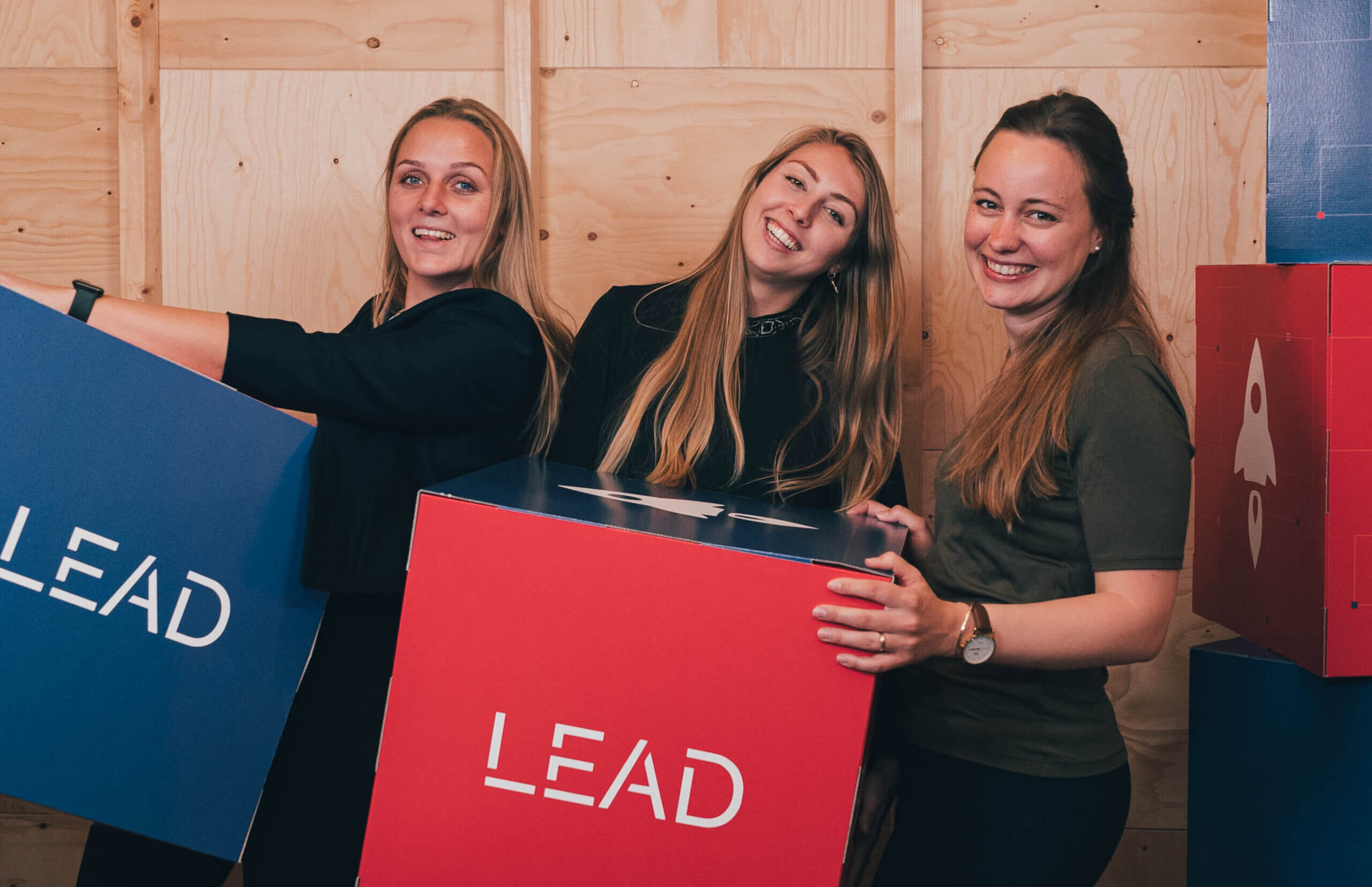Target group segmentation in lead generation: why it’s important.

Why audience segmentation is such an important part of lead generation, and how you can do it too.
Selling a product or service is not just about having the best product. Selling a product involves many other important factors, such as a good sales strategy -check out our tips on this in our blog, but also knowing who your audience is and how your product or service taps into their needs. Businesses do this by dividing their prospects in different customer groups. Dividing your customers in these groups is what we call target group segmentation.
Target group segmentation can feel a bit technical oftentimes, however, it’s the foundation of a good sales and marketing strategy. It’ll make or break your campaigns.
What is Target Group Segmentation?
Target group segmentation is the process of dividing a large and diverse group of customers into smaller subgroups based on specific characteristics. This allows companies to understand and target their customers more effectively, resulting in improved marketing efforts and increased lead generation.
After segmenting your target group, creating a persona can help to dive deeper into the needs and characteristics of your target group. A persona is a fictional character that represents a particular type of user or customer that an organization is trying to target. A persona is created based on research and data about the behaviors, motivations, and goals of real users, and is used to help designers, marketers, and product developers make decisions about what kind of products or experiences to create. Personas help to create a deeper understanding of the people that an organization is serving, and can be used to make sure that products are designed with the needs and wants of those people in mind. By creating personas, organizations can develop a more nuanced understanding of their target group, and make sure that their products and services are more effective in meeting their needs.
In this article, we’ll explore why target group segmentation is important in lead generation, how it can help companies achieve their goals and how to build your own persona based on your segmented group.
Want to skip this and read further on how to conduct a target group segmentation? Check the section below!
Why is Target Group Segmentation Important in Lead Generation?
- Better Lead Qualification:
Target group segmentation helps businesses to qualify their leads more effectively. By understanding their target audience and what they are looking for, businesses can identify the leads that are most likely to become customers. This helps businesses to focus their efforts on the most qualified leads and avoid wasting time and resources on leads that are unlikely to convert.
2. Increased Relevance:
By creating a more relevant and personalized experience for each segment, businesses can increase the effectiveness of their marketing and sales efforts. For example, if a business sells a wide range of products, they may segment their audience based on demographics, buying habits, interests, and other relevant characteristics. This information can then be used to create targeted messages and offers that resonate with each segment, improving the chances of a successful conversion.
Additionally, target group segmentation can help businesses optimize their marketing and advertising spend by focusing their efforts on the segments that are most likely to respond to their offerings. By understanding the needs, preferences, and behaviors of different segments, businesses can create more impactful campaigns, resulting in increased relevance, engagement, and ultimately, conversions.
In conclusion, target group segmentation is a critical component of effective lead generation. By dividing their audience into smaller groups, companies can tailor their marketing messages to the specific needs and interests of each segment, identify their most valuable customers, reduce the cost of their marketing efforts, better understand their customers’ needs and pain points, and build stronger relationships with their customers. With the right target group segmentation strategy, companies can improve the effectiveness of their marketing efforts, generate more leads, and achieve their sales goals.
3. Improved Targeting:
With target group segmentation, businesses can target their marketing efforts more effectively. By dividing their audience into smaller groups, businesses can target each group with more precision and relevance. This improved targeting results in higher conversion rates and a better return on investment. Companies can get a better understanding of which segments are driving the most sales and engagement. This information can then be used to prioritize marketing efforts and allocate resources more effectively.
For example, if a company finds that their high-end products are particularly popular with a certain segment, they may want to focus their marketing efforts on this group to maximize their return on investment.
4. Increased Personalization:
Target group segmentation allows businesses to personalize their marketing messages for each group. Personalization helps businesses to build trust and credibility with their audience, which leads to higher engagement and conversion rates. By personalizing their messages, businesses can show their audience that they understand their needs and are offering them a solution that is tailored to their specific needs. By dividing their audience into smaller groups, companies can gain a deeper understanding of the unique challenges and needs of each segment. This information can then be used to create more effective marketing messages and improve the overall customer experience.
For example, if a company finds that a certain segment is struggling with a specific pain point, such as managing their finances, they may want to focus their marketing efforts on this group and create educational content to help them overcome their challenges.

5. Better Budget Allocation:
Target group segmentation helps businesses to allocate their marketing budget more effectively. By understanding their target audience and what they respond to, businesses can allocate their budget to the channels and tactics that are most likely to reach and convert their target audience. This helps businesses to get the most value from their marketing efforts and maximize their return on investment. By targeting their marketing messages more effectively, companies can reduce the number of unsuccessful campaigns and avoid wasting resources on ineffective marketing efforts.
For example, if a company knows that a certain segment is not interested in a particular product, they can avoid investing time and money into a marketing campaign that is unlikely to generate any leads or sales.
6. Better Understanding of Your Target Group:
Target group segmentation helps businesses to understand their target audience more accurately. By understanding their audience, businesses can create relevant messages, advertisements, and offers that resonate with their audience, improving the chances that their marketing efforts will be successful.
For example, if a company sells athletic apparel, they may segment their audience based on factors such as age, gender, fitness level, and interests. This allows them to create marketing messages that are specifically tailored to each segment, such as promoting a new line of athletic wear for women over 50, or highlighting the benefits of a new running shoe for seasoned runners.
This also counts for B2B businesses, as not each business is the same and have different ways of decision making. Where you would segment less on behavioral characteristics, it’s good to focus on other characteristics such as demographics. This article written by B2B International has a great strategy on how to specifically segment B2B businesses in your strategy.
Looking even beyond this point, understanding what your target audience pain points are makes it easier for you to optimize your product and tap into a deeper need.
Now you know the benefits of target group segmentation, let’s dive deeper into how to conduct a target group segmentation.
Conducting a target group segmentation is a process of dividing your target market into smaller groups of consumers with similar needs or characteristics. This can help you tailor your marketing efforts and messaging to each specific group, leading to higher engagement and conversion rates. Here’s how to conduct a target group segmentation:
- Define your target market: Start by defining the audience you want to reach. Consider factors such as demographics, behaviors, psychographics, and geography. For B2B businesses you would look at company and contact levels: demographic characteristics, industry, FTE and specialties. You segment your contacts on job titles, job level etc.
- Collect data: Gather data on your target market. This can include both qualitative and quantitative data. Qualitative data, such as focus groups and surveys, can provide insight into consumer attitudes and behaviors. Quantitative data, such as demographic information and purchase history, can provide a more objective picture of your target market. Looking for some great data providers? Let us know! We know the market.
- Analyze the data: Use the data you have collected to identify patterns and similarities among your target audience. Look for common characteristics, behaviors, and attitudes.
- Develop personas: Based on your analysis, create personas for each segment of your target audience. These personas should be based on the characteristics and behaviors of real consumers and should help you understand each segment’s motivations, needs, and goals. We’ll dive a little deeper into creating a persona later in this article.
- Test and refine: Test your personas and audience segments by using them to guide your marketing efforts. Use metrics such as conversion rates and engagement to evaluate the effectiveness of your efforts and make changes as needed.
- Repeat the process: Target group segmentation is not a one-time process. As your target market changes and evolves, it’s important to repeat the process to ensure your segments are up to date and relevant.
Keep in mind when conducting a target group segmentation that the most important factor is to identify the key characteristics that distinguish different groups within your audience. It’s essential to have a clear understanding of your audience’s needs, preferences, behaviors, and motivations to create a segmentation that’s useful and actionable. By segmenting your audience, you can tailor your messaging, products, and services to better meet their needs and improve the effectiveness of your marketing efforts.
Therefore, the most important thing when doing an audience segmentation is to carefully analyze data and insights about your audience to identify the most significant and relevant characteristics and create well-defined audience segments that allow you to deliver personalized, relevant and effective messages to each group.

Building a persona
Building a persona is an extension of your target group segmentation and is a representation of your segmented group. When creating a persona, you’ll dive deeper into your target audience to fully understand their behavior, needs and interests. To start, we’ll have a look at the research we’ve already done for the audience segmentation.
1. Consider demographics: Take the group you want to target (your segmented audience) and consider their demographic factors such as age, gender, income, education and location as well as psychographic factors such as values, interests and lifestyle.
2. Conduct research: Once you have defined your audience, you need to conduct research to better understand them. This can include surveys, focus groups, interviews, and other market research methods to gather information about your target audience’s attitudes, behaviors, pain points, and goals.
3. Identify key traits: Use the data you’ve collected to identify key traits that are common among your target audience. This might include interests, hobbies, values, purchasing habits, and communication preferences.
4. Create a profile: Based on the key traits you have identified, create a profile of your ideal customer. This should include details such as their name, age, occupation, hobbies, and other relevant information that will help you understand them better.
5. Identify pain points and motivations: Once you have a profile of your ideal customer, identify their pain points and motivations. What problems do they face, and what are they looking for in a solution? What are their goals and aspirations, and how can your product or service help them achieve those goals?
6. Use the persona to inform marketing & sales strategy: With a detailed persona in hand, you can use it to inform your marketing strategy. Use the persona to craft messaging that resonates with your target audience, create content that speaks to their pain points and motivations, and choose the channels that they are most likely to use. Moreover, you can use your persona for your buying cycle. At a basic level, you will have four stages:
- Awareness: The prospect gets acquainted with your brand.
- Consideration: The prospect will seek to rationalise their purchase, using case studies, reviews and testimonials.
- Decision: The prospect is comfortable to commit to a purchase.
- Action: The prospect completes the desired action
By defining your buying process, and how your consumers behave, you can effectively determine different types of content for each stage.
7. Continuously refine the persona: Remember that your persona is not a static document. As you gather more data and feedback from your target group, use that information to refine and update the persona, ensuring that it continues to accurately reflect the needs and desires of your ideal customer. Also, remind your team of your persona. Give it a name and a face. Your team will remember who they do the work for.
Overall, building a persona for target group segmentation requires a mix of research, analysis, and creativity. By taking the time to understand your target audience and craft a detailed persona, you can create more effective marketing campaigns that resonate with your customers and drive results. Buyer personas help you understand your customers (and prospective customers) better. This makes it easier for you to tailor your content, messaging, product development, and services to meet the specific needs, behaviors, and concerns of the members of your target audience. Make sure you align your segmented audience and personas with your sales strategy if you really want to take things to the next level.
Want to learn more about a solid sales strategy? Check out our blog on how to do that. Already created your persona but no idea on how to attract them? Check out our blog on lead generation through content marketing. Want to skip all of this and get started with lead generation? Plan a demo with Laura.
—
Read this blog in Dutch



